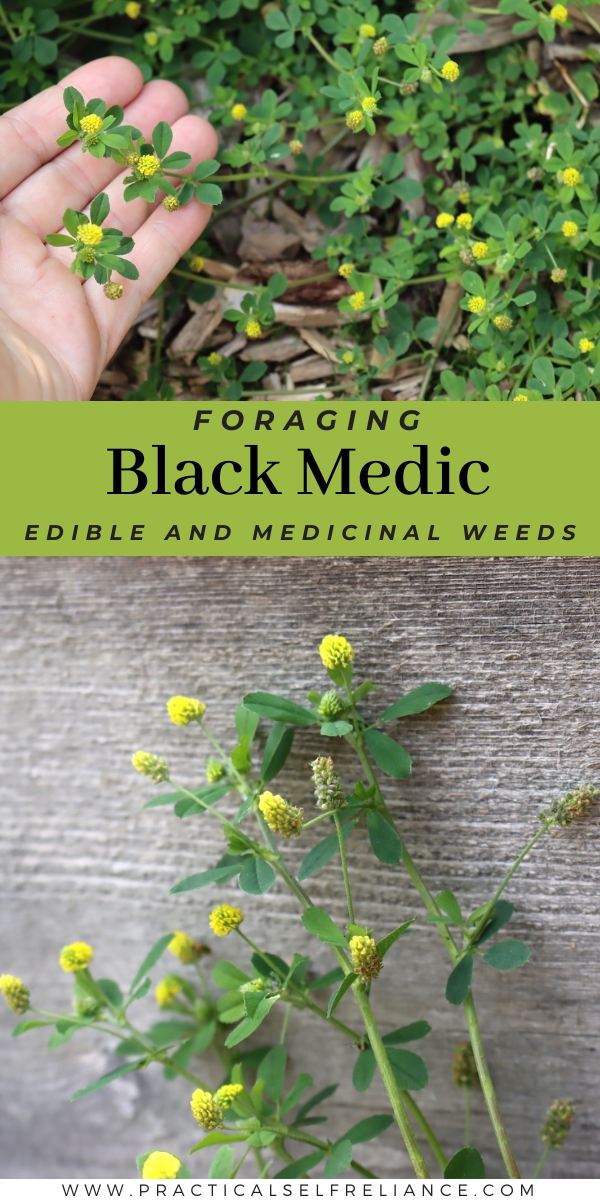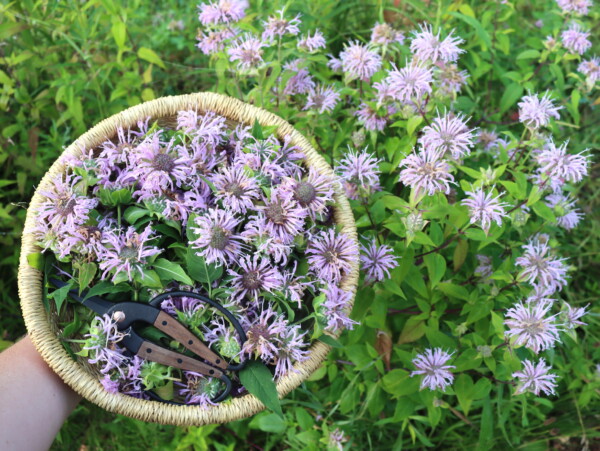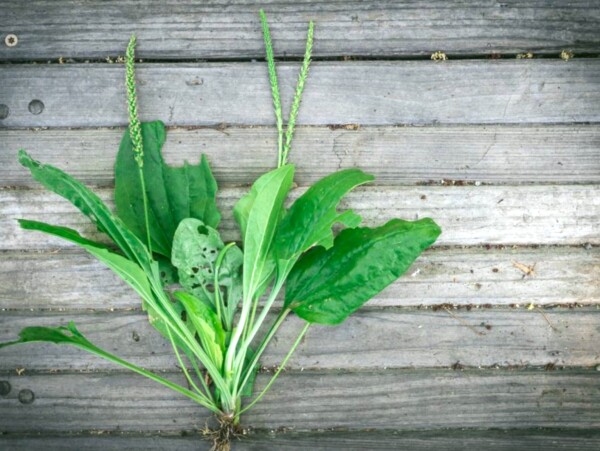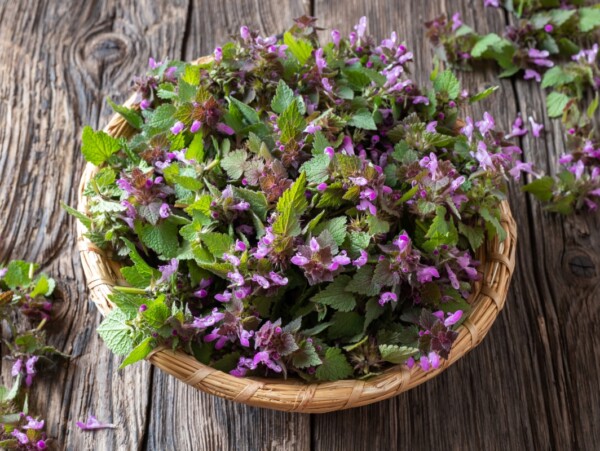Affiliate disclosure: This post may contain affiliate links. Please see our Privacy Policy.
Black Medic (Medicago lupulina) is a small, low-growing weed with yellow flowers that look a bit like clover. It’s not related to clover, and is actually much closer to alfalfa botanically. Either way, it is an edible and medicinal weed worth knowing.

Black medic is popular with herbalists, but foragers love it too as a prolific edible weed. It looks a bit like clover, but they’re not quite the same, and there are ways to tell the difference.
(I actually had some really great pictures of yellow clover and black medic growing side by side from a few years back, but I can’t seem to find the pictures on my hard drive. I’ll dig them up eventually, but in the meantime, know that it’s similar at a glance, but you can follow the ID guide below to tall them apart.)
What is Black Medic?
Black Medic (Medicago lupulina) is a common prostrate herbaceous weed that has naturalized throughout the United States and Southern Canada. It’s originally native to Europe and temperate Asia and is known by several common names, including Black Medick, Yellow Trefoil, English Trefoil, Black Clover, Hop Medic, Nonesuch, Blackweed, Black Hay, or Hop Clover.
Black Medic is part of the Fabaceae family, also called the pea or legume family. While not a true clover, it’s closely related to true clovers and is in the same genus as Alfalfa, Medicago.
Gardeners often classify Black Medica as an annual, but oftentimes, at least a few plants will overwinter. Often, Black Medic acts more like a short-lived perennial.

Is Black Medic Edible?
Black Medic is edible. You can eat the leaves and flowers raw or cooked. However, most foragers find that they don’t have excellent flavor when raw and prefer to use them as a potherb.
The seeds are also edible but provide the most nutrition after being sprouted, parched, or roasted. This is because they, like some other seeds in the legume family, contain “trypsin inhibitors,” which prevent humans from digesting them properly. Processing destroys these inhibitors. Many foragers grind the cooked or sprouted seeds into flour.
You can also use Black Medic Medicinally. Herbalists will use Black Medic internally and externally for digestive issues, wound care, and infections.
While not as potent and nutritious as alfalfa, Black Medic also makes decent fodder for livestock. Sheep will feed on Black Medic, but cows usually ignore it. It also makes a good meadow species for beekeepers.
Like other clover relatives, Black Medic may have some estrogenic properties. Consult with your doctor before consuming Black Medic if you’re pregnant or breastfeeding.
Black Medic also contains the amino acid L-Canavanine, which can aggravate lupus and other autoimmune disorders. It can also interact with certain medications, like blood thinners and diabetes medications. If you suffer from one of these conditions or take prescription medication, consult your physician before using Black Medic.
Black Medic Medicinal Benefits
Historically, herbalists have used Black Medic for digestive issues, blood clotting, wound care, and treating infections. Black Medic acts as a mild laxative, and herbalists use it to improve digestion and treat constipation.
Black Medic assists in blood clotting and has antibacterial properties. Herbalists have used the dried or powdered leaves to stop wounds from bleeding. It also aids in blood clotting and treating infections when taken internally.
Black Medic can also help promote health and weight loss more broadly. Black Medic leaves are high in protein and fiber, helping improve digestion and making people feel fuller.
One recent study explored the properties of two types of Black Medic extracts: glycerol extract and polypropylene glycol extract. Scientists found that both extracts displayed “notable antioxidant, anti-lipoxygenase and anti-α-amylase activity.” They also noted that the glycerol extract may be a good choice for antidiabetic food supplements and cosmeceutical products.
Another study tested the properties of a methanolic extract of Black Medic leaves. This study found that the extract had good antibacterial activity against several types of bacteria, including Bacillus subtilis, Escherichia coli, Pseudomonas aeruginosa, Salmonella typhi, and Staphylococcus aureus. It also indicated that the Black Medic extract had good antifungal activity, insecticidal activity, and good to moderate anti-tumor activity.
Where to Find Black Medic
Native to Europe and temperate Asia, Black Medic has naturalized and can be found in the United States, including Hawaii and Alaska, South America, southern Canada, Australia, New Zealand, Japan, and South Africa.
It thrives in full sun in areas with poor soil and low nitrogen levels. It also thrives in compacted soil, dry areas, and drought conditions but won’t tolerate acidic soil.
You can find Black Medic growing in open, weedy areas like disturbed and waste places, lawns, fields, gardens, and along roadsides and railroads.
When to Find Black Medic
Black Medic usually appears in spring, around May, when the weather starts to warm, and it grows through the summer and into September. Those in southern areas will spot Black Medic long before those in northern regions. In warm climates, it may even be present from April through October.
Black Medic is most noticeable in the late spring or summer when it produces little yellow blossoms. Usually, the plants die off in fall or early winter when cold temperatures come. However, a few may remain throughout the winter. These hardy plants still typically die back some and resume growing in the spring.
Identifying Black Medic
Black Medic is a low-growing herbaceous weed with distinctive clover-like leaves. The stems often grow flat, creeping along the ground, but some may grow erect. It’s often tough to pick out unless it’s in bloom and you spot the rounded, yellow flower clusters. It reproduces exclusively from seed but is vigorous and can form large colonies in ideal habitats. The plants produce deep taproots, which allow them to thrive in drought conditions.

Black Medic Leaves
Black Medic has clover-like, trifoliate leaves comprising three dark green, oval leaflets covered in fine, silvery hair. The leaves are arranged alternately on the stem, and there is a pair of stipules, or leaf-like appendages, where each leaf petiole or stem connects to the main stem.
Each leaflet has a small spur or tooth at the tip, toothed margins, and prominent parallel veins. These features help distinguish Black Medic from true clovers and other legumes. The leaflets are usually ½ to ¾ inch long, and the center leaflet is on a slightly extended petiole or stem.
Black Medic Stems
Black Medic will grow many stems from the base of one plant. The stems may grow 8 to 31 inches long and usually are prostrate, creeping along the ground, but sometimes grow more erect. Very young stems may occasionally be smooth but are hairy on more mature plants. The stems are somewhat square.
Black Medic Flowers
Black Medic produces small, rounded to slightly elongated, bright yellow flower clusters that form on stems growing from the leaf axils. Each cluster is comprised of 10 to 50 bright yellow flowers. The clusters may grow up to ⅓ of an inch long on larger plants. You may spot Black Medic flowers throughout the growing season, but individual plants stop flowering once they produce seeds.

Black Medic Seeds
The flowers give way to clusters of kidney-shaped seed pods 1.5 to 3 mm in diameter that ripen from green or greenish-purple to black. The seed pods each contain a single gold or brown seed.
Black Medic Look-Alikes
Black Medic is sometimes mistaken for Yellow Wood Sorrel (Oxalis stricta). However, it differs in several noticeable ways:
- Each Yellow Wood Sorrel leaf is made up of three heart-shaped leaflets, which are creased at the center and fold up at night or when stressed.
- Yellow Wood Sorrell has open, cup-like flowers up to ½ inch in diameter, each with five petals.
- The flowers are followed by erect, elongated, green seed pods that burst apart when touched when ripe.
Another look-alike is Lesser Hop Trefoil (Trifolium dubium). However, it too can be distinguished in a few ways:
- Lesser Hop Trefoil leaves are usually hairless or may have a few hairs around the margins.
- Lesser Hop Trefoil leaflets lack a tooth at the tips.
- Lesser Hop Trefoil has round flowerheads containing 15 to 20 flowers.
- Lesser Hop Trefoil has brown seed heads.
Hop Trefoil (Trifolium campestre) can also be mistaken for Black Medic. Here are a few ways to tell them apart:
- Hop Trefoil has large, pale yellow pompom-like flowerheads.
- Hope Trefoil has sparsely hairy leaves that lack a tooth on the tips.
- Hop Trefoil has brown seed heads.
Like the other trefoils, the Large Hop Trefoil (Trifolium aureum) also looks similar to Black Medic at first glance. Here are a couple of ways to differentiate the two:
- Large Hope Trefoil leaflets lack a tooth at the tips.
- Large Hop Trefoil has larger round or oval flower heads ½ to ¾ inch long, densely packed with yellow flowers.
- Large Hop Trefoil seed heads mature to brown.
Lastly, White Clover (Trifolium repens) may be confused with Black Medic, but there are a few easy ways to tell them apart:
- White Clover has trifoliate leaves with three rounded leaflets that each have a pale chevron shape at the center.
- White Clover leaflets lack a tooth at the tips.
- White Clover has white or pink-tinged round flower heads.
- White Clover spreads through stolons or creeping stems that root at the nodes.
Ways to Use Black Medic
The leaves and flowers are the easiest part of Black Medic to collect and use. While you can eat them raw, they can be a little bitter. I recommend using them cooked as a potherb like collards or spinach. Add some great nutrition and protein to casseroles, stir-fries, soups, and other recipes you’d normally add greens to.
The seeds of Black Medic are also edible but should be roasted, parched, or sprouted before use. After processing, you can grind the seeds into flour or add them to recipes as you would other seeds. When roasted, the seeds are excellent on oatmeal, salads, or stir-fries. They also make an excellent addition to granola, crackers, muffins, and other baked goods.
Medicinally, you can use Black Medic internally or externally. Use the leaves and flowers in teas and tinctures to treat infections and digestive issues. You can also keep some dried or powdered leaves on hand to stop bleeding on minor cuts and wounds.
Black Medic Recipes
- Create a Black Medic infusion or decoction with these simple instructions from Mountain Rose Herbs.
- Alternatively, you can preserve your Black Medic in a tincture with this basic homemade tincture tutorial.




